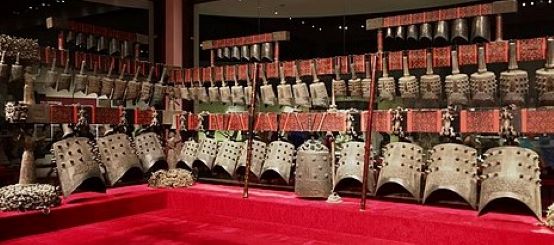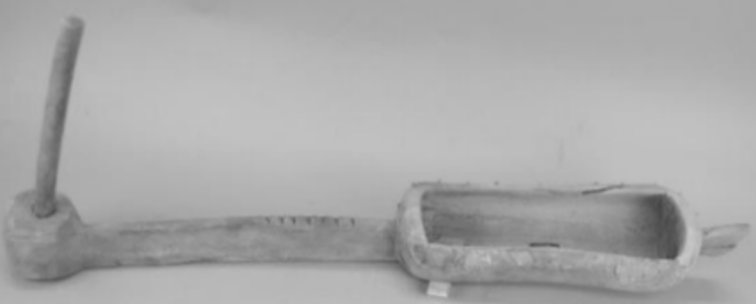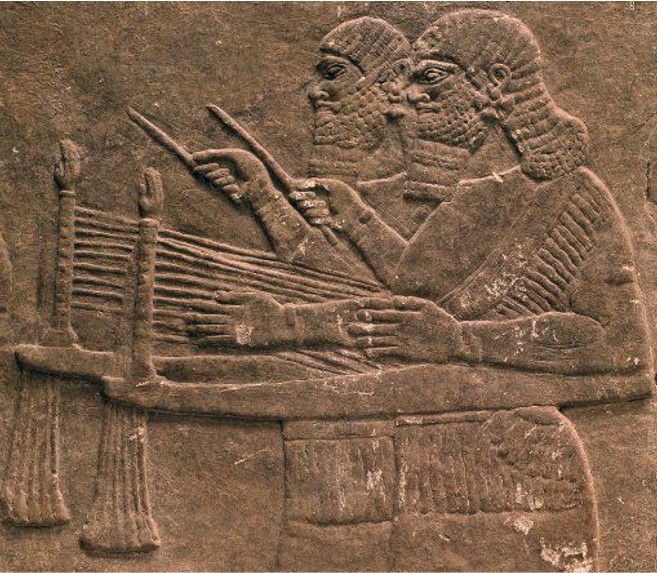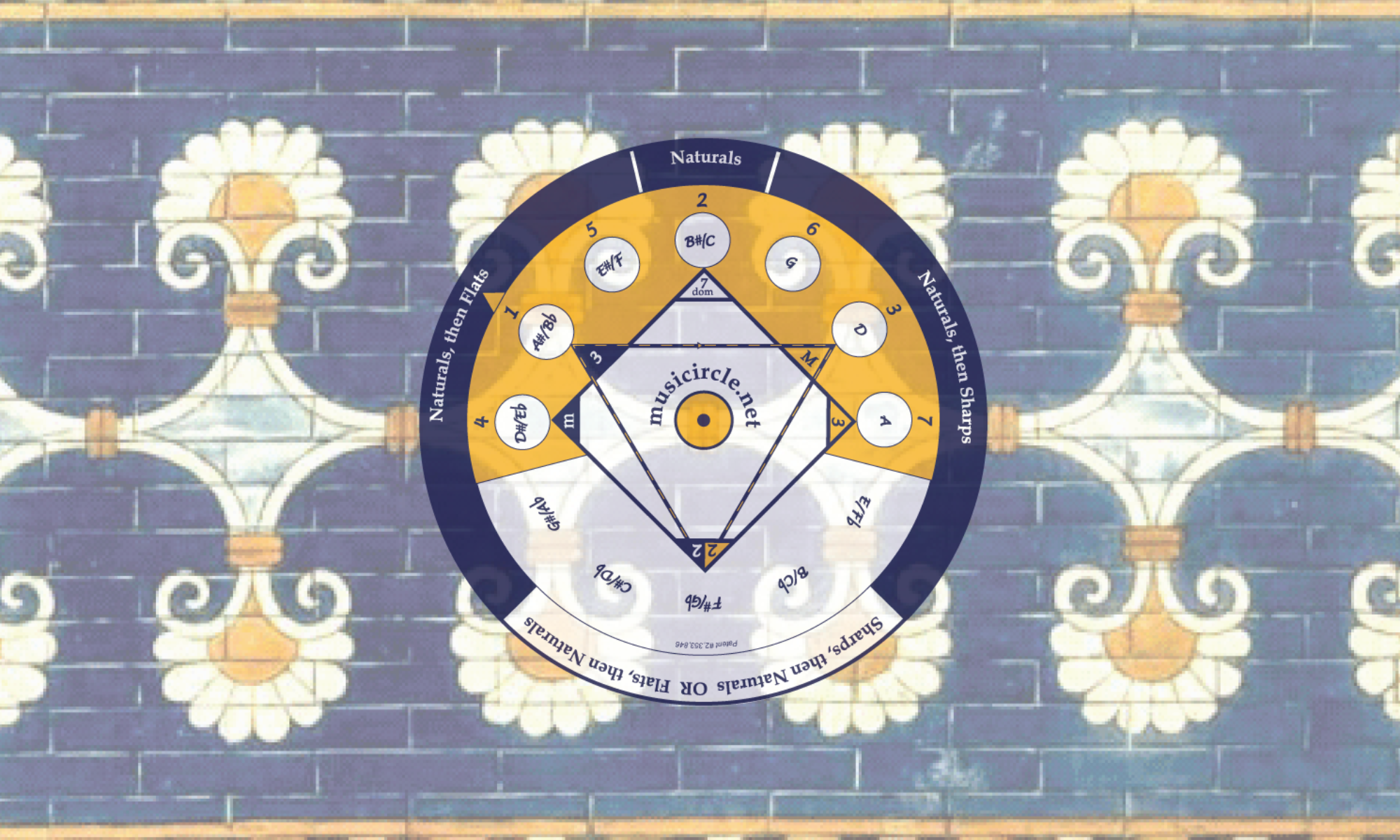The Lǚshì chūnqiū, written in 239 BC, documents that the ancient Chinese had knowledge of the circle of fifths, from which they created the shí’èr lǜ (十二律), or “twelve-pitch” system.
Each of the twelve shí’èr lǜ pitches is generated by multiplying the previous pitch by 2/3 and, in some cases, also by 2 – which simply doubles the string length of a pitch, generating its lower octave. Multiplying by 2 is done to keep all twelve pitches within a single octave, thereby creating a chromatic scale. To learn more about this doubling process, watch the video The Origin of the Sequence 4,1,5,2,6,3,7.
Seven of the twelve shí’èr lǜ pitches pitches – those generated by multiplying by both 2/3 and 2 (or by 4/3, because 2/3 x 2 = 4/3) – are described in the Lǚshì chūnqiū as being obtained by “up-generation.” The remaining five pitches – those generated by multiplying only by 2/3 – are described as being obtained by “down-generation.” For this reason, the pitch-generation process described in the Lǚshì chūnqiū is often referred to as the ancient Chinese “up-and-down principle.”
The Lǚshì chūnqiū lists the twelve pitches in two different orders: in circle of fifths order and in chromatic order. If we write the pitches in the first – circle of fifths – order, but using numbers instead of their Chinese names and writing the up-generations in bold, and the down-generations not bolded, we get: 1,1,2,2,3,3,4,5,4,6,5,7. Then, if we re-arrange our numbers to give the pitches in chromatic order, as the Lǚshì chūnqiū does, we get: 1,5,2,6,3,7,4,1,4,2,5,3.
The sequence of numbers 1,5,2,6,3,7,4 (and its inversions) forms the basis of the Mesopotamian musical system. For example, it is written in the third column of the table drawn on Mesopotamian tablet CBS 1766, which dates to the first millennium BC.

Several octaves of the shí’èr lǜ twelve-pitch scale are played by the bell-set (Biānzhōng) of Marquis Yi, which was discovered in 1977, in his tomb, which dates to 433 BC. Yet inscriptions on the bells also indicate that the shí’èr lǜ system was used by the ancient Chinese to generate scales having fewer than twelve notes, most notably a five-note scale. A handful of ancient texts and some earlier bell sets indicate that the ancient Chinese also used a seven-note scale – a scale identical to that used by the Mesopotamians.

Further evidence of Mesopotamian-Chinese musical contact has come to light in the last few decades. Beginning in 1996, in Xinjiang Uyghur Autonomous Region, in the far west of China, archaeologists began discovering ancient harps (konghou). Some of these konghou are more than 500 years older than the oldest stringed instrument previously known in China.

The twenty-three konghou found between 1996 and 2021 all strongly resemble the “angular harp” that was invented in Mesopotamia around 1900 BC. As described in a paper by Xie Jin, published by the Shanghai Conservatory of Music: “there are many similarities between the konghous in Xinjiang and the harps in Pazyryk, Assyria, and Olbia, which show that…musical communication had already begun between Xinjiang and those regions before the fifth century BC.”

Yet not only do these konghou resemble instruments from farther west – as far west as Assyria (Mesopotamia) – some of the occupants of the graves in which the konghou were found are Europoid. According to archaeological evidence, these Europoid people – now popularly referred to as the Tarim Basin mummies – began arriving in the region as early as 1800 BC, bringing with them technologies not yet known in China, most importantly bronze and wheeled, horse-drawn vehicles.

To learn more about the musical system of ancient China and its relationship the Mesopotamian musical system, read the paper “A Proposed Mesopotamian Origin for the Ancient Musical and Musico-Cosmological Systems of the West and China,” published by Sino-Platonic Papers, a journal founded by Victor H. Mair, a professor at the University of Pennsylvania.
Victor H. Mair, who, among other things, is renown for his archaeological work on the Tarim mummies, says the following about de Rose’s work:
“Sara de Rose has made a tremendous breakthrough in the study of ancient east-west cultural communications. Professor Lothar von Falkenhausen, eminent archeologist and musicologist at UCLA, has this to say about Sara’s work: “Using sources previously unavailable, the article brings the two traditions closer together than ever before, and it certainly goes some way toward tipping the balance for the argument to diffusion over independent invention.” He goes on to explain: “The principal portion of the article, showing the mathematical-musicological parallels between tone-generation methods in ancient Mesopotamia and early China are extremely interesting and well presented. With respect to showing these parallels, and pointing out concrete structural similarities between China and Mesopotamia, it seems to me that the author is really making an important contribution.” ”
Professor Mair goes on to say “Sara’s opus is one of the most important papers we have ever published in SPP. Knowing something about Sara’s life story, all the more I consider her to be a genuinely clairvoyant genius.”
